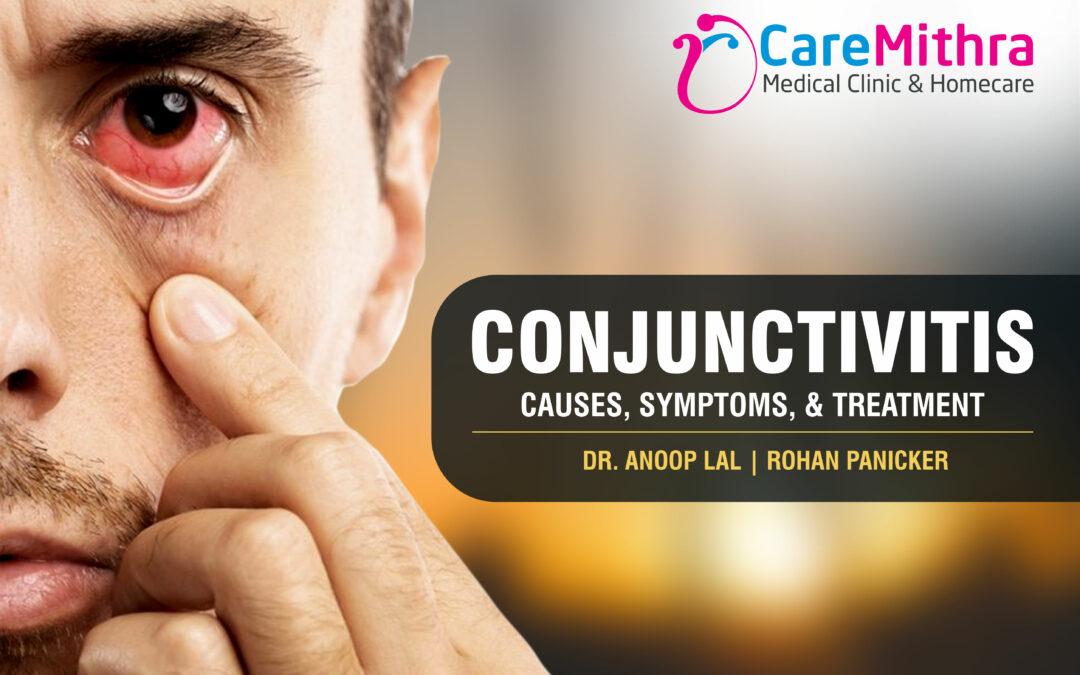Conjunctivitis, commonly referred to as “pink eye” or “red eye”, is a very common and highly contagious eye condition affecting millions of people worldwide every year. While it is often considered a minor ailment, conjunctivitis can be uncomfortable and disruptive if left untreated. This article will explain the causes, symptoms, and treatment options for conjunctivitis, shedding light on this common eye disease.
Conjunctivitis is an inflammation of the conjunctiva, the thin, transparent layer of tissue that covers the white part of the eye and lines the inner surface of the eyelids. This inflammation can be caused by various factors, including viral or bacterial infections, allergies, irritants, or underlying health conditions.
Causes of Conjunctivitis:
Viral Conjunctivitis– This type of conjunctivitis is typically caused by the same viruses responsible for the common cold, such as adenoviruses. They are highly contagious and spread through contact with infected respiratory droplets or touching contaminated surfaces.
Bacterial Conjunctivitis– Bacterial infections, commonly due to strains of staphylococcus or streptococcus, can lead to bacterial conjunctivitis. It can result from direct contact from bacteria to eye or be secondary to an upper respiratory infection.
Allergic Conjunctivitis– Allergens such as pollen, pet dander, dust mites, and certain chemicals can trigger allergic reactions in the eyes, leading to allergic conjunctivitis. This type of conjunctivitis is not contagious and often occurs seasonally or in response to specific environmental triggers. It is strongly linked to allergic rhinitis (hay fever) and sinusitis and often occur together.
Irritant Conjunctivitis: Exposure to irritants like smoke, chlorine in swimming pools, air pollutants, or foreign bodies can cause irritation and inflammation of the conjunctiva, resulting in irritant conjunctivitis.
Conjunctivitis in Newborns: Newborns can acquire conjunctivitis during delivery if the mother has a sexually transmitted infection such as chlamydia or gonorrhoea. This condition, known as neonatal conjunctivitis or ophthalmia neonatorum, requires prompt treatment (antibiotics, eye irrigation etc) to prevent serious complications.
Symptoms of Conjunctivitis:
The symptoms of conjunctivitis can vary depending on the underlying cause but commonly include:
- Redness in the white part of the eye or inner eyelids
- Watery or mucous discharge from the eyes
- Itchiness, burning, or gritty sensation in the eyes
- Swelling of the eyelids
- Increased sensitivity to light
- Crusting of eyelashes, especially upon waking in the morning
In viral conjunctivitis, symptoms may affect one or both eyes and often start in one eye before spreading to the other. Bacterial conjunctivitis typically produces more significant discharge, often thick and yellow or greenish in colour, while allergic conjunctivitis is often accompanied by sneezing, nasal congestion, or itching in other parts of the body.
Treatment Options:
The treatment of conjunctivitis depends on the underlying cause:
Viral Conjunctivitis: Since viral conjunctivitis is caused by a virus, antibiotics are ineffective. Treatment focuses on managing symptoms with cold compresses, artificial tears, and over-the-counter antihistamine or decongestant eye drops to alleviate discomfort and inflammation. In severe cases, a doctor may prescribe antiviral medications.
Bacterial Conjunctivitis: Bacterial conjunctivitis may require antibiotic eye drops or ointments to clear the infection. It’s essential to complete the full course of antibiotics as prescribed by the doctor to prevent recurrence or antibiotic resistance.
Allergic Conjunctivitis: Avoiding allergens and using antihistamine eye drops or oral medications can help alleviate symptoms of allergic conjunctivitis. In severe cases, a doctor may recommend prescription-strength medications or immunotherapy for long-term management.
Irritant Conjunctivitis: Removing the irritant and rinsing the eyes with clean water can help relieve symptoms of irritant conjunctivitis. Artificial tears or lubricating eye drops may also provide relief from discomfort.
For all types of conjunctivitis, practicing good hygiene, such as frequently washing hands with soap and using hand sanitizer, avoiding rubbing the eyes, and not sharing towels or eye makeup, can help prevent the spread of infection and reduce the risk of recurrence. It is also ideal to isolate from those with the illness to minimise contact, reduce and prevent the spread of infection. Due to the increased risk of irritation worsening and deepening of infection, avoid wearing contact lenses and going to swimming pools when having this condition.
When to Seek Medical Attention
While most cases of conjunctivitis resolve on their own or with simple home remedies, certain symptoms warrant prompt medical attention. These include:
- Severe eye pain
- Blurred vision or changes in vision
- Sensitivity to light accompanied by severe headache
- Symptoms that worsen or fail to improve after a few days
- Symptoms in newborns or infants
In conclusion, conjunctivitis is a common eye condition with various causes, including viral or bacterial infections, allergies, or irritants. While it can be uncomfortable and contagious, most cases of conjunctivitis respond well to treatment and resolve without complications. However, it’s essential to seek medical attention if symptoms persist or worsen to rule out more serious underlying conditions and receive appropriate care. With proper management and preventive measures, individuals can minimize the impact of conjunctivitis on their eye health and overall well-being.
Article Credits
Dr. Anoop Lal, Medical Director, CareMithra
Rohan Panicker, Content Writer, CareMithra





